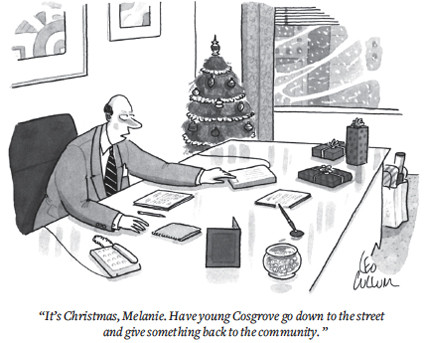 (Cartoon by Leo Collum/The New Yorker Collection)
(Cartoon by Leo Collum/The New Yorker Collection)
In many organizations today, leaders put a premium on making their workplace more diverse. Not only does diversity promote the values of fairness and equal opportunity, it’s also potentially good for the bottom line. Some studies, for example, have shown that diversity can enhance employee performance.
But recent work by scholars at the University of Minnesota suggests that the benefits of workplace diversity extend beyond company walls. The researchers focused on the workforce of a large university, and they analyzed how differences in gender and ethnicity affected the amount of money that university employees contributed to a workplace charity drive. Because funds raised by such campaigns flow to people outside the organization, they offer one way to assess the impact of diversity on society at large.
The researchers collected a data set that combined demographic information from the university’s human resources department with information on the employees’ contributions to an annual charity drive. Their sample covered 487 administrative work units and included more than 16,000 people.
The study revealed some intriguing patterns. Women, overall, donated more per person than men did. But in work units where the percentage of women was higher than average, the level of giving by men was higher as well. “There was a spillover effect,” says study co-author Lisa Leslie, a psychologist at the University of Minnesota’s Carlson School of Management.
Leslie and her colleagues considered but ruled out several possible explanations for this finding before concluding that it was most consistent with social role theory. According to social role theory, people assume that women have an inclination to help others, and they expect women to contribute to charity at high levels. An increased presence of women in a workplace, therefore, would arguably increase the willingness among men to give to charity—even if they don’t actually know how much their female colleagues have donated.
Members of minority groups, overall, donated less per person than whites did. In work units with higher-than-average minority representation, however, the donation level among minority members was also higher. What’s more, it was higher representation among black employees that largely accounted for this pattern.
The researchers explain that result by reference to social exchange theory. Because blacks have experienced a greater degree of disadvantage than other ethnic groups in the United States, they are less likely to feel generosity toward society as a whole, the researchers argue. Yet a relatively high level of black representation within a work unit might signal that conditions are improving, thereby increasing the inclination among black employees to support a charity drive.
All in all, these results send a compelling message to organizational leaders who want to strengthen the connection between their company and their community. “There are positive synergies between diversity and corporate social responsibility,” Leslie says.
Support SSIR’s coverage of cross-sector solutions to global challenges.
Help us further the reach of innovative ideas. Donate today.
Read more stories by Corinna Wu.

